Nigerian vs Inupiat Community Comparison
COMPARE
Nigerian
Inupiat
Social Comparison
Social Comparison
Nigerians
Inupiat
1,996
SOCIAL INDEX
17.5/ 100
SOCIAL RATING
277th/ 347
SOCIAL RANK
2,695
SOCIAL INDEX
24.5/ 100
SOCIAL RATING
244th/ 347
SOCIAL RANK
Inupiat Integration in Nigerian Communities
The statistical analysis conducted on geographies consisting of 82,846,818 people shows a moderate positive correlation between the proportion of Inupiat within Nigerian communities in the United States with a correlation coefficient (R) of 0.489. On average, for every 1% (one percent) increase in Nigerians within a typical geography, there is an increase of 0.010% in Inupiat. To illustrate, in a geography comprising of 100,000 individuals, a rise of 1,000 Nigerians corresponds to an increase of 10.0 Inupiat.
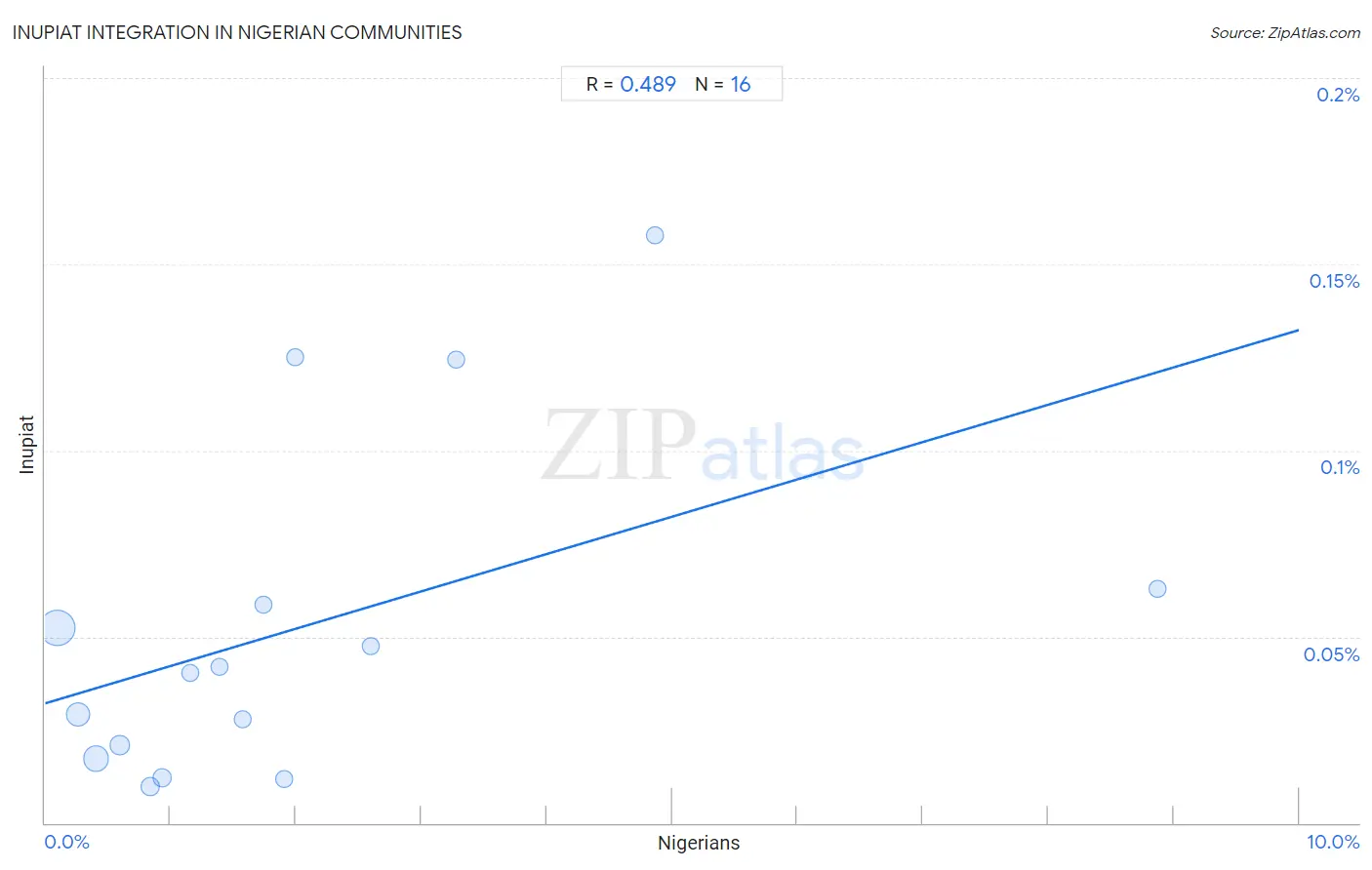
Nigerian vs Inupiat Income
When considering income, the most significant differences between Nigerian and Inupiat communities in the United States are seen in householder income under 25 years ($49,416 compared to $55,935, a difference of 13.2%), per capita income ($41,026 compared to $36,999, a difference of 10.9%), and wage/income gap (23.0% compared to 20.8%, a difference of 10.6%). Conversely, both communities are more comparable in terms of median female earnings ($39,641 compared to $40,080, a difference of 1.1%), householder income over 65 years ($58,992 compared to $61,061, a difference of 3.5%), and median household income ($81,725 compared to $78,841, a difference of 3.7%).

| Income Metric | Nigerian | Inupiat |
| Per Capita Income | Tragic $41,026 | Tragic $36,999 |
| Median Family Income | Tragic $97,522 | Tragic $91,730 |
| Median Household Income | Poor $81,725 | Tragic $78,841 |
| Median Earnings | Fair $45,532 | Tragic $43,000 |
| Median Male Earnings | Tragic $52,039 | Tragic $47,281 |
| Median Female Earnings | Average $39,641 | Good $40,080 |
| Householder Age | Under 25 years | Tragic $49,416 | Exceptional $55,935 |
| Householder Age | 25 - 44 years | Tragic $87,730 | Tragic $84,619 |
| Householder Age | 45 - 64 years | Tragic $95,492 | Tragic $91,355 |
| Householder Age | Over 65 years | Poor $58,992 | Average $61,061 |
| Wage/Income Gap | Exceptional 23.0% | Exceptional 20.8% |
Nigerian vs Inupiat Poverty
When considering poverty, the most significant differences between Nigerian and Inupiat communities in the United States are seen in single male poverty (12.9% compared to 20.0%, a difference of 54.7%), receiving food stamps (13.1% compared to 20.1%, a difference of 53.1%), and married-couple family poverty (5.5% compared to 7.1%, a difference of 30.1%). Conversely, both communities are more comparable in terms of single mother poverty (29.3% compared to 29.0%, a difference of 1.1%), child poverty among boys under 16 (18.5% compared to 18.1%, a difference of 2.3%), and child poverty under the age of 16 (18.4% compared to 19.2%, a difference of 4.2%).
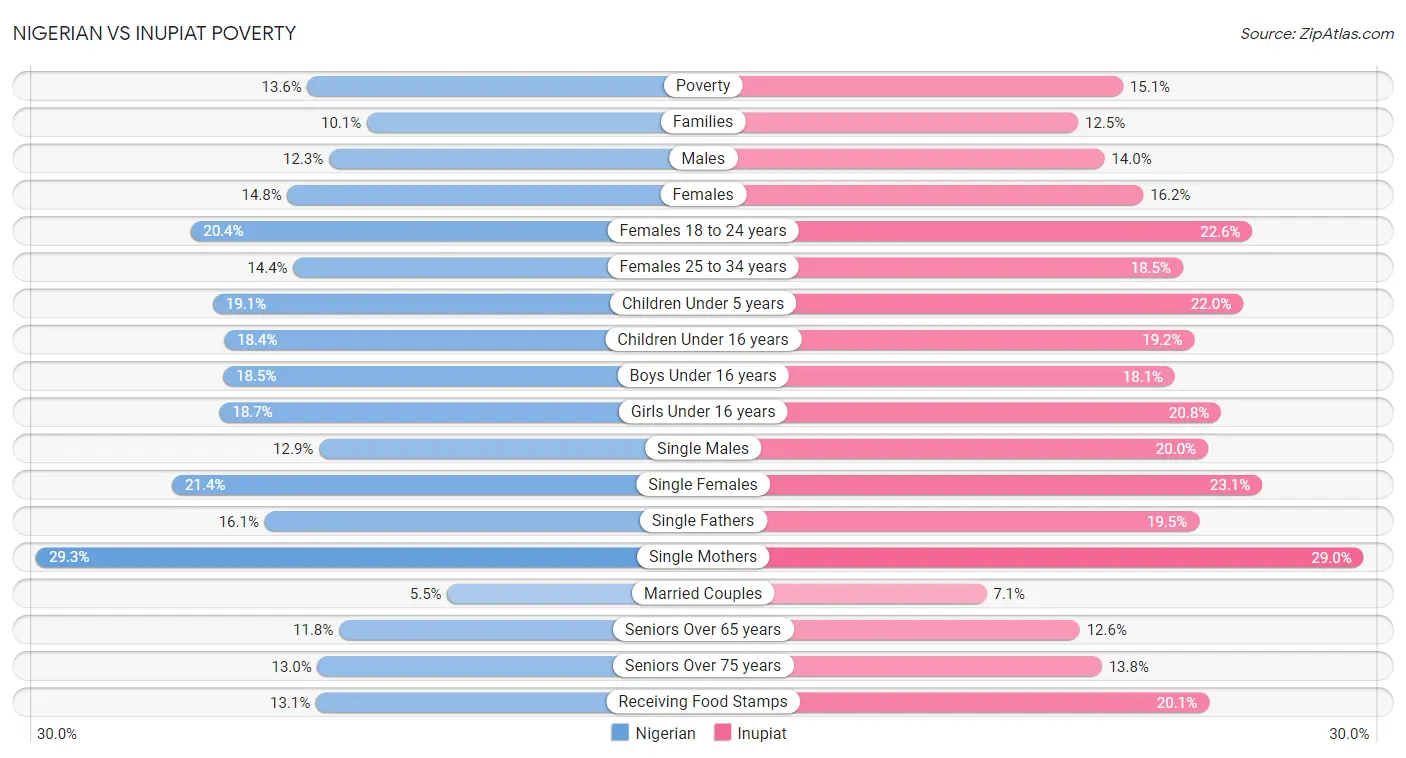
| Poverty Metric | Nigerian | Inupiat |
| Poverty | Tragic 13.6% | Tragic 15.1% |
| Families | Tragic 10.1% | Tragic 12.5% |
| Males | Tragic 12.3% | Tragic 14.0% |
| Females | Tragic 14.8% | Tragic 16.2% |
| Females 18 to 24 years | Fair 20.4% | Tragic 22.6% |
| Females 25 to 34 years | Tragic 14.4% | Tragic 18.5% |
| Children Under 5 years | Tragic 19.1% | Tragic 22.0% |
| Children Under 16 years | Tragic 18.4% | Tragic 19.2% |
| Boys Under 16 years | Tragic 18.5% | Tragic 18.1% |
| Girls Under 16 years | Tragic 18.7% | Tragic 20.8% |
| Single Males | Fair 12.9% | Tragic 20.0% |
| Single Females | Fair 21.4% | Tragic 23.1% |
| Single Fathers | Good 16.1% | Tragic 19.5% |
| Single Mothers | Fair 29.3% | Good 29.0% |
| Married Couples | Poor 5.5% | Tragic 7.1% |
| Seniors Over 65 years | Tragic 11.8% | Tragic 12.6% |
| Seniors Over 75 years | Tragic 13.0% | Tragic 13.8% |
| Receiving Food Stamps | Tragic 13.1% | Tragic 20.1% |
Nigerian vs Inupiat Unemployment
When considering unemployment, the most significant differences between Nigerian and Inupiat communities in the United States are seen in unemployment among women with children under 6 years (8.2% compared to 17.7%, a difference of 115.4%), male unemployment (5.9% compared to 12.1%, a difference of 103.8%), and unemployment among ages 45 to 54 years (4.7% compared to 9.2%, a difference of 97.3%). Conversely, both communities are more comparable in terms of unemployment among seniors over 75 years (9.7% compared to 9.1%, a difference of 5.9%), unemployment among seniors over 65 years (5.3% compared to 5.8%, a difference of 9.2%), and unemployment among ages 65 to 74 years (5.5% compared to 7.5%, a difference of 35.5%).
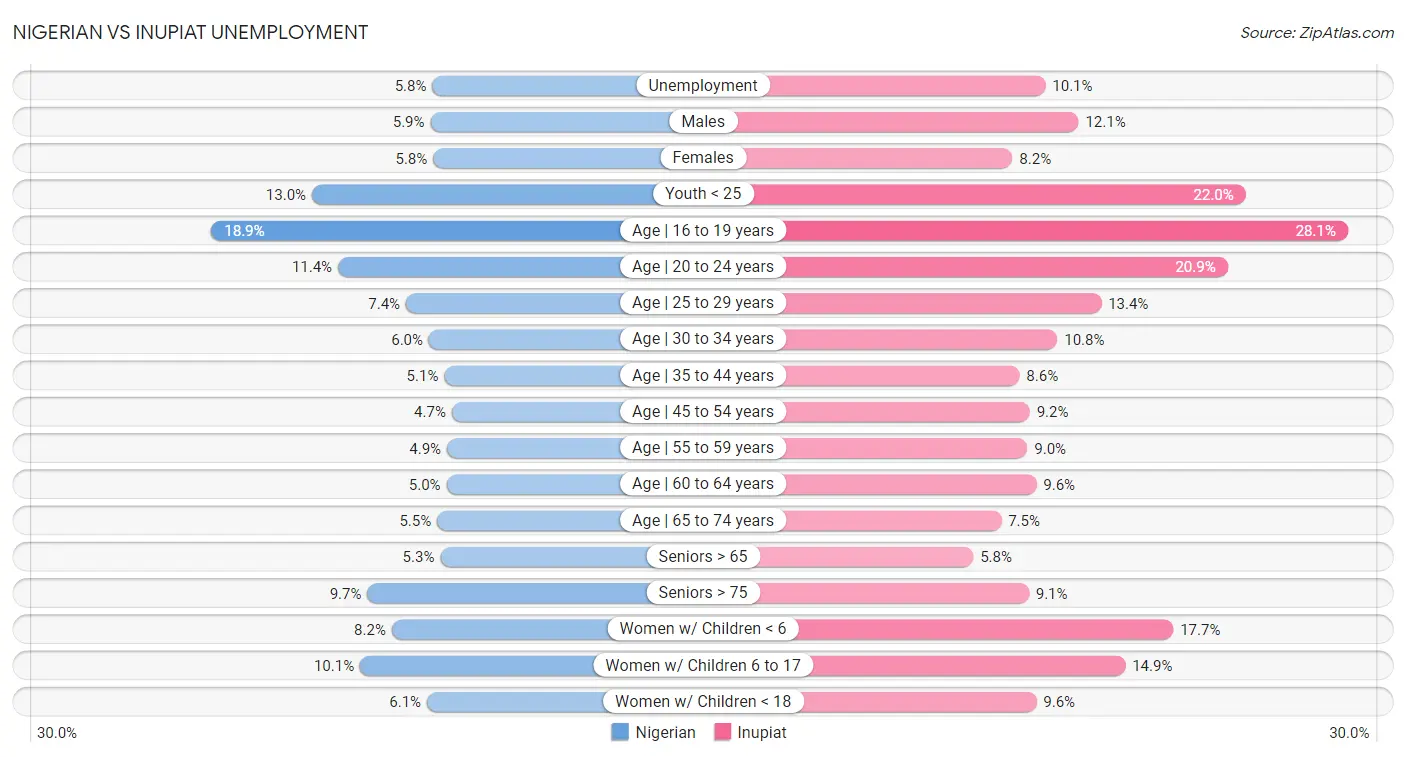
| Unemployment Metric | Nigerian | Inupiat |
| Unemployment | Tragic 5.8% | Tragic 10.1% |
| Males | Tragic 5.9% | Tragic 12.1% |
| Females | Tragic 5.8% | Tragic 8.2% |
| Youth < 25 | Tragic 13.0% | Tragic 22.0% |
| Age | 16 to 19 years | Tragic 18.9% | Tragic 28.1% |
| Age | 20 to 24 years | Tragic 11.4% | Tragic 20.9% |
| Age | 25 to 29 years | Tragic 7.4% | Tragic 13.4% |
| Age | 30 to 34 years | Tragic 6.0% | Tragic 10.8% |
| Age | 35 to 44 years | Tragic 5.1% | Tragic 8.6% |
| Age | 45 to 54 years | Tragic 4.7% | Tragic 9.2% |
| Age | 55 to 59 years | Tragic 4.9% | Tragic 9.0% |
| Age | 60 to 64 years | Tragic 5.0% | Tragic 9.6% |
| Age | 65 to 74 years | Tragic 5.5% | Tragic 7.5% |
| Seniors > 65 | Tragic 5.3% | Tragic 5.8% |
| Seniors > 75 | Tragic 9.7% | Tragic 9.1% |
| Women w/ Children < 6 | Tragic 8.2% | Tragic 17.7% |
| Women w/ Children 6 to 17 | Tragic 10.1% | Tragic 14.9% |
| Women w/ Children < 18 | Tragic 6.1% | Tragic 9.6% |
Nigerian vs Inupiat Labor Participation
When considering labor participation, the most significant differences between Nigerian and Inupiat communities in the United States are seen in in labor force | age 30-34 (84.5% compared to 79.7%, a difference of 6.1%), in labor force | age 25-29 (84.3% compared to 79.8%, a difference of 5.6%), and in labor force | age 20-64 (79.7% compared to 76.1%, a difference of 4.7%). Conversely, both communities are more comparable in terms of in labor force | age 20-24 (74.7% compared to 74.6%, a difference of 0.10%), in labor force | age 16-19 (36.1% compared to 35.0%, a difference of 3.0%), and in labor force | age 45-54 (82.7% compared to 79.9%, a difference of 3.5%).

| Labor Participation Metric | Nigerian | Inupiat |
| In Labor Force | Age > 16 | Exceptional 66.6% | Tragic 64.3% |
| In Labor Force | Age 20-64 | Good 79.7% | Tragic 76.1% |
| In Labor Force | Age 16-19 | Fair 36.1% | Tragic 35.0% |
| In Labor Force | Age 20-24 | Fair 74.7% | Poor 74.6% |
| In Labor Force | Age 25-29 | Tragic 84.3% | Tragic 79.8% |
| In Labor Force | Age 30-34 | Fair 84.5% | Tragic 79.7% |
| In Labor Force | Age 35-44 | Average 84.4% | Tragic 80.9% |
| In Labor Force | Age 45-54 | Average 82.7% | Tragic 79.9% |
Nigerian vs Inupiat Family Structure
When considering family structure, the most significant differences between Nigerian and Inupiat communities in the United States are seen in single father households (2.4% compared to 4.9%, a difference of 106.6%), births to unmarried women (35.3% compared to 52.1%, a difference of 47.4%), and family households with children (28.4% compared to 32.8%, a difference of 15.5%). Conversely, both communities are more comparable in terms of married-couple households (43.2% compared to 42.4%, a difference of 1.8%), currently married (43.4% compared to 41.3%, a difference of 5.2%), and family households (63.9% compared to 67.8%, a difference of 6.1%).

| Family Structure Metric | Nigerian | Inupiat |
| Family Households | Poor 63.9% | Exceptional 67.8% |
| Family Households with Children | Exceptional 28.4% | Exceptional 32.8% |
| Married-couple Households | Tragic 43.2% | Tragic 42.4% |
| Average Family Size | Exceptional 3.29 | Exceptional 3.63 |
| Single Father Households | Average 2.4% | Tragic 4.9% |
| Single Mother Households | Tragic 7.7% | Tragic 8.5% |
| Currently Married | Tragic 43.4% | Tragic 41.3% |
| Divorced or Separated | Fair 12.1% | Exceptional 11.4% |
| Births to Unmarried Women | Tragic 35.3% | Tragic 52.1% |
Nigerian vs Inupiat Vehicle Availability
When considering vehicle availability, the most significant differences between Nigerian and Inupiat communities in the United States are seen in no vehicles in household (12.1% compared to 29.9%, a difference of 147.6%), 2 or more vehicles in household (52.8% compared to 42.6%, a difference of 23.8%), and 1 or more vehicles in household (88.0% compared to 71.5%, a difference of 23.0%). Conversely, both communities are more comparable in terms of 4 or more vehicles in household (6.0% compared to 6.2%, a difference of 3.1%), 3 or more vehicles in household (18.6% compared to 16.9%, a difference of 10.3%), and 1 or more vehicles in household (88.0% compared to 71.5%, a difference of 23.0%).

| Vehicle Availability Metric | Nigerian | Inupiat |
| No Vehicles Available | Tragic 12.1% | Tragic 29.9% |
| 1+ Vehicles Available | Tragic 88.0% | Tragic 71.5% |
| 2+ Vehicles Available | Tragic 52.8% | Tragic 42.6% |
| 3+ Vehicles Available | Tragic 18.6% | Tragic 16.9% |
| 4+ Vehicles Available | Poor 6.0% | Fair 6.2% |
Nigerian vs Inupiat Education Level
When considering education level, the most significant differences between Nigerian and Inupiat communities in the United States are seen in no schooling completed (2.3% compared to 1.5%, a difference of 54.1%), bachelor's degree (37.2% compared to 25.8%, a difference of 44.2%), and master's degree (14.9% compared to 10.5%, a difference of 41.7%). Conversely, both communities are more comparable in terms of 12th grade, no diploma (90.3% compared to 90.1%, a difference of 0.26%), high school diploma (88.2% compared to 88.5%, a difference of 0.38%), and 11th grade (91.8% compared to 92.4%, a difference of 0.68%).
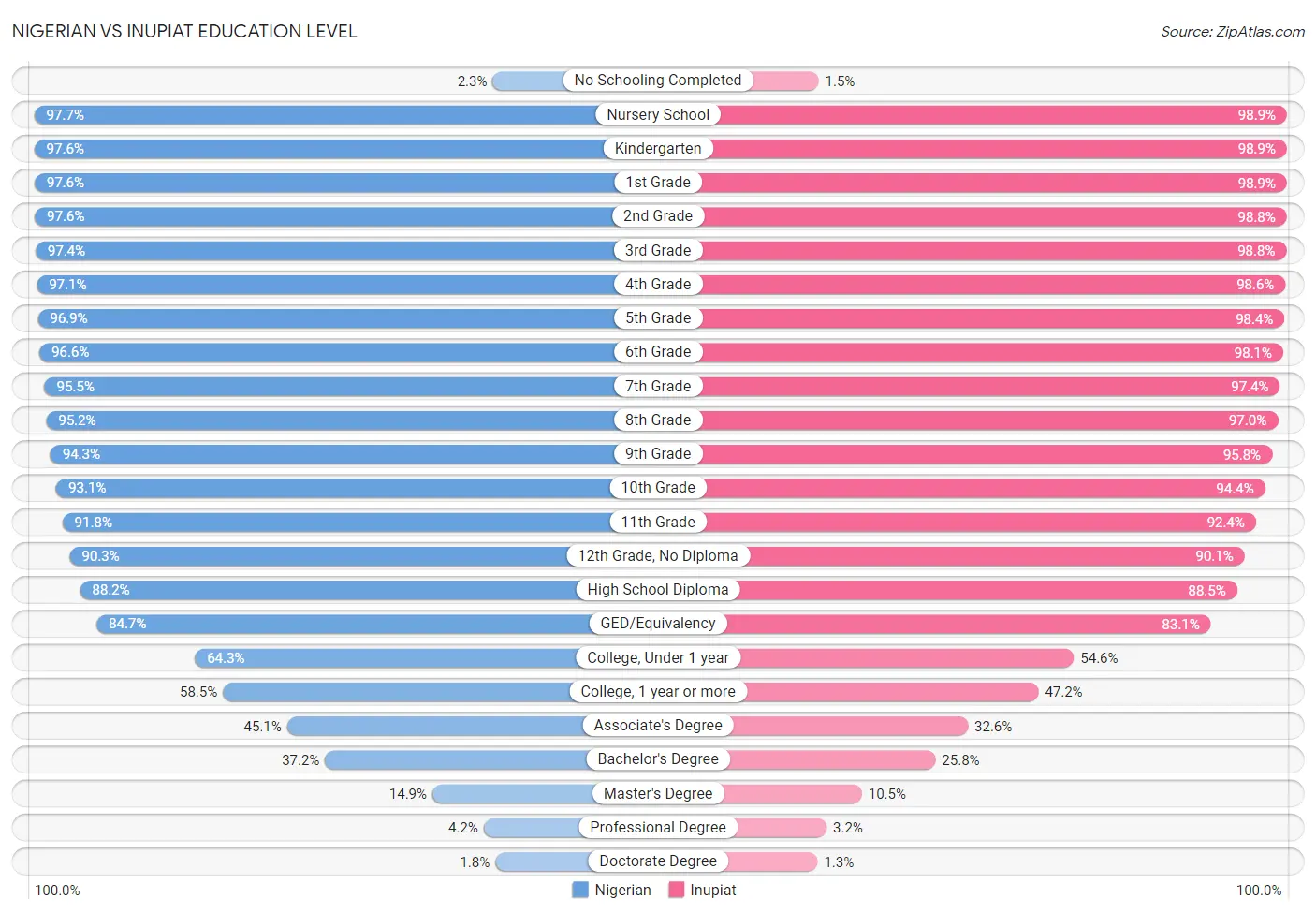
| Education Level Metric | Nigerian | Inupiat |
| No Schooling Completed | Tragic 2.3% | Exceptional 1.5% |
| Nursery School | Tragic 97.7% | Exceptional 98.9% |
| Kindergarten | Tragic 97.6% | Exceptional 98.9% |
| 1st Grade | Tragic 97.6% | Exceptional 98.9% |
| 2nd Grade | Tragic 97.6% | Exceptional 98.8% |
| 3rd Grade | Tragic 97.4% | Exceptional 98.8% |
| 4th Grade | Tragic 97.1% | Exceptional 98.6% |
| 5th Grade | Tragic 96.9% | Exceptional 98.4% |
| 6th Grade | Tragic 96.6% | Exceptional 98.1% |
| 7th Grade | Tragic 95.5% | Exceptional 97.4% |
| 8th Grade | Tragic 95.2% | Exceptional 97.0% |
| 9th Grade | Tragic 94.3% | Exceptional 95.8% |
| 10th Grade | Tragic 93.1% | Exceptional 94.4% |
| 11th Grade | Tragic 91.8% | Average 92.4% |
| 12th Grade, No Diploma | Tragic 90.3% | Tragic 90.1% |
| High School Diploma | Tragic 88.2% | Poor 88.5% |
| GED/Equivalency | Tragic 84.7% | Tragic 83.1% |
| College, Under 1 year | Poor 64.3% | Tragic 54.6% |
| College, 1 year or more | Fair 58.5% | Tragic 47.2% |
| Associate's Degree | Poor 45.1% | Tragic 32.6% |
| Bachelor's Degree | Fair 37.2% | Tragic 25.8% |
| Master's Degree | Average 14.9% | Tragic 10.5% |
| Professional Degree | Fair 4.2% | Tragic 3.2% |
| Doctorate Degree | Fair 1.8% | Tragic 1.3% |
Nigerian vs Inupiat Disability
When considering disability, the most significant differences between Nigerian and Inupiat communities in the United States are seen in disability age under 5 (1.3% compared to 3.7%, a difference of 190.6%), hearing disability (2.6% compared to 4.7%, a difference of 78.5%), and disability age 65 to 74 (24.2% compared to 34.5%, a difference of 42.8%). Conversely, both communities are more comparable in terms of disability age 5 to 17 (5.8% compared to 5.7%, a difference of 1.6%), disability age 18 to 34 (6.6% compared to 6.5%, a difference of 2.6%), and disability (11.5% compared to 12.2%, a difference of 5.6%).
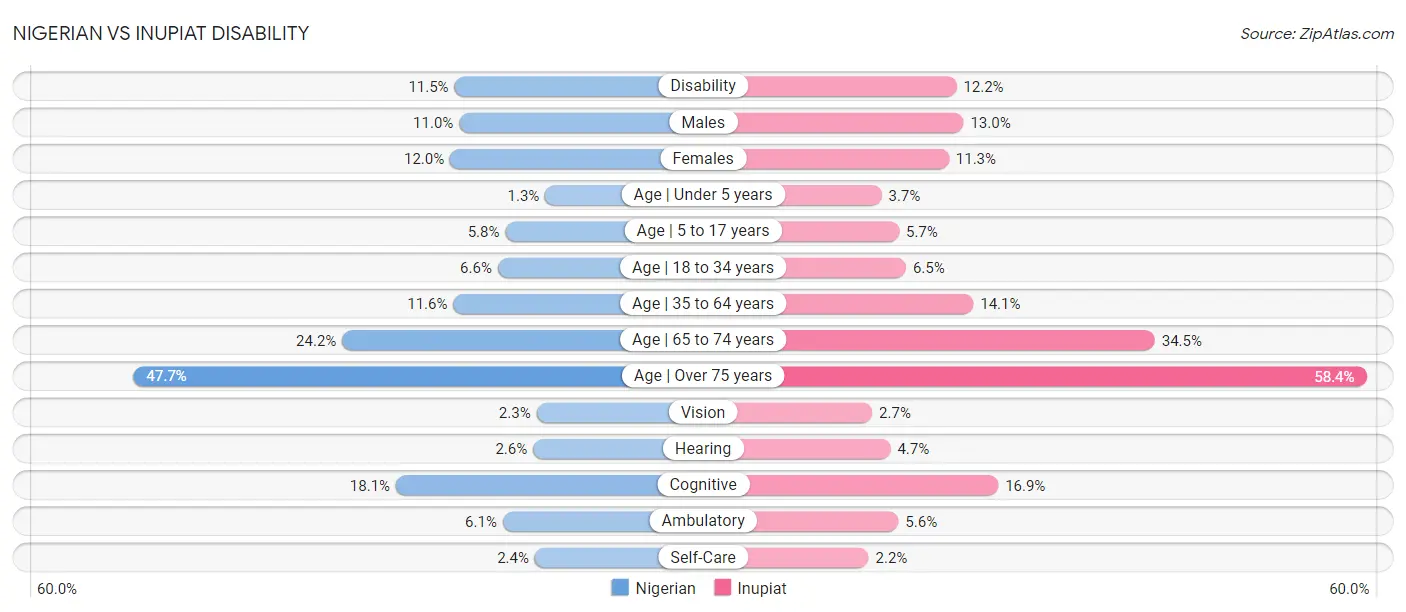
| Disability Metric | Nigerian | Inupiat |
| Disability | Excellent 11.5% | Tragic 12.2% |
| Males | Excellent 11.0% | Tragic 13.0% |
| Females | Excellent 12.0% | Exceptional 11.3% |
| Age | Under 5 years | Fair 1.3% | Tragic 3.7% |
| Age | 5 to 17 years | Tragic 5.8% | Fair 5.7% |
| Age | 18 to 34 years | Average 6.6% | Good 6.5% |
| Age | 35 to 64 years | Poor 11.6% | Tragic 14.1% |
| Age | 65 to 74 years | Tragic 24.2% | Tragic 34.5% |
| Age | Over 75 years | Poor 47.7% | Tragic 58.4% |
| Vision | Tragic 2.3% | Tragic 2.7% |
| Hearing | Exceptional 2.6% | Tragic 4.7% |
| Cognitive | Tragic 18.1% | Exceptional 16.9% |
| Ambulatory | Good 6.1% | Exceptional 5.6% |
| Self-Care | Good 2.4% | Exceptional 2.2% |